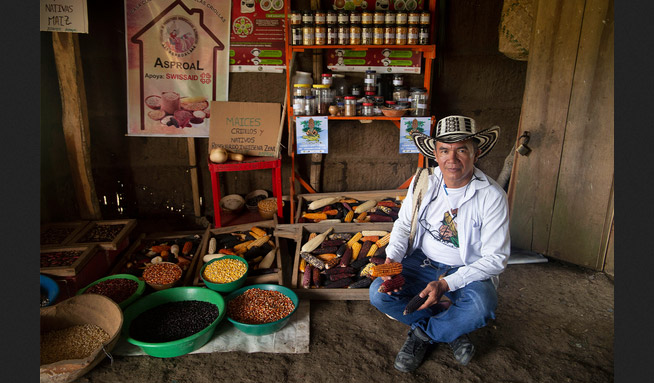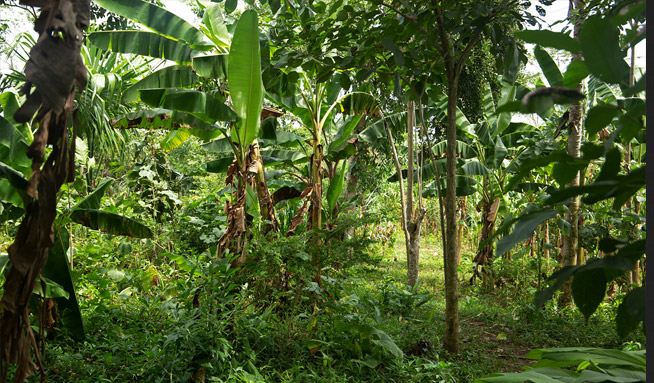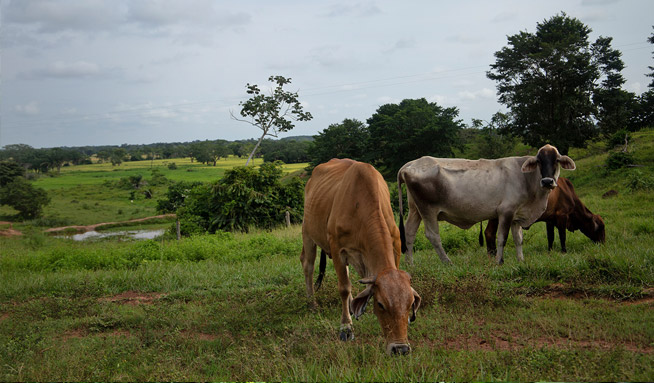- In response to last year’s record-breaking heat due to El Niño and impacts from climate change, Indigenous Zenù farmers in Colombia are trying to revive the cultivation of traditional climate-resilient seeds and agroecology systems.
- One traditional farming system combines farming with fishing: locals fish during the rainy season when water levels are high, and farm during the dry season on the fertile soils left by the receding water.
- Locals and ecologists say conflicts over land with surrounding plantation owners, cattle ranchers and mines are also worsening the impacts of the climate crisis.
- To protect their land, the Zenù reserve, which is today surrounded by monoculture plantations, was in 2005 declared the first Colombian territory free from GMOs.
MONTERÍA, Colombia — “Look at the rooms in our house,” says Remberto Gil, 45, during a sweltering day last September. “During this time of the year, they are typically overflowing with freshly harvested corn to the point where we only have space to sleep in hammocks hanging over the cobs.”
An Indigenous Zenù farmer, Gil lives in the Zenù reserve of San Andrés de Sotavento, a nearly 10,000-hectare (25,000-acre) piece of land that’s home to 33,000 people in northwestern Colombia.
“Now, everything is empty,” he adds. “We lost around 90% of the first harvest due to drought, and the little corn we have now is smaller than usual. We had no rain during the last month, and now we can’t sow.”
In the Zenù reserve, issues with the weather, climate or soil are spread by word of mouth between farmers, or on La Positiva 103.0, a community agroecology radio station. And what’s been on every farmer’s mind is last year’s record-breaking heat and droughts. Both of these were charged by the twin impacts of climate change and a newly developing El Niño, a naturally occurring warmer period that last occurred here in 2016, say climate scientists.
Experts from Colombia’s Institute of Hydrology, Meteorology and Environmental Studies say the impacts of El Niño will be felt in Colombia until April 2024, adding to farmers’ concerns. Other scientists forecast June to August may be even hotter than 2023, and the next five years could be the hottest on record. On Jan. 24, President Gustavo Petro said he will declare wildfires a natural disaster, following an increase in forest fires that scientists attribute to the effects of El Niño.

In the face of these changes, Zenù farmers are trying to revive traditional agricultural practices like ancestral seed conservation and a unique agroecology system.
“Climate change is scary due to the possibility of food scarcity,” says Rodrigo Hernandez, a local authority with the Santa Isabel community. “Our ancestral seeds offer a solution as more resistant to climate change.”
Based on their experience, farmers say their ancestral seed varieties are more resistant to high temperatures compared to the imported varieties and cultivars they currently use. These ancestral varieties have adapted to the region’s ecosystem and require less water, they tell Mongabay. According to a report by local organization Grupo Semillas and development foundation SWISSAID, indigenous corn varieties like blaquito are more resistant to the heat, cariaco tolerates drought easily, and negrito is very resistant to high temperatures.
The Zenù diet still incorporates the traditional diversity of seeds, plant varieties and animals they consume, though they too are threatened by climate change: from fish recipes made from bocachico (Prochilodus magdalenae), and reptiles like the babilla or spectacled caiman (Caiman crocodilus), to different corn varieties to prepare arepas (cornmeal cakes), liquor, cheeses and soups.
“The most important challenge we have now is to save ancient species and involve new generations in ancestral practice,” says Sonia Rocha Marquez, a professor of social sciences at Sinù University in the city of Montería.

Living on a golden caiman
According to traditional Zenù beliefs, the land where the Zenù reserve sits is protected by a giant golden caiman buried underground, symbolized today by the spectacled caimans found throughout their ancestral territory. To protect what legally remains as their land, which is today surrounded by monoculture plantations, mostly cotton, the reserve in 2005 became the first Colombian territory declared free from GMOs.
Zenù farmers say they worry that the use of genetically modified seeds will lead to the advance of industrial agriculture models on their land, destroy its biodiversity, and contaminate their ancestral seed varieties, especially corn.
In the reserve, locals say conflicts over land with surrounding plantation owners are also worsening the impacts of the climate crisis and El Niño. Until the end of the ’90s, Zenù farmers were engaged in violent struggles with Colombian paramilitary groups to recover land originally reserved for them by the Spanish crown. Today, they’re engaged in disputes with industrial farmers and cattle ranchers, who now own chunks of their ancestral land around the reserve.
“During the ’70s, I was actively involved in conflicts for land possession between farmers and big land owners and armed groups in the Zenù reserve,” says Victor Negrete, a professor at Sinù University. “We fought but we didn’t manage to get a huge part of the territory. Now, the challenges are still related to lack of land and water resources, narcotrafficking, the presence of armed groups, extensive grazing, contamination, and monoculture plantations.”

But despite this land scarcity, Negrete says communities are developing important projects to protect their traditional food systems. Farmers and seed custodians, like Gil, are working with the Association of Organic Agriculture and Livestock Producers (ASPROAL) and their Communitarian Seed House (Casa Comunitaria de Semillas Criollas y Nativas).
“During the Colombian civil war, people were killed by security forces, hitmen, or displaced, and had their lands were burned. We lost a lot of our agricultural knowledge and seeds during that time,” Gil says. ASPROAL was born in response to this, to preserve the richness of their food culture, and the Communitarian Seed House followed after the 2016 El Niño drought.
Located near Gil’s house, the seed bank hosts a rainbow of 12 corn varieties, from glistening black to blue to light pink to purple and even white. There are also jars of seeds for local varieties of beans, eggplants, pumpkins and aromatic herbs, some stored in refrigerators. All are ancient varieties shared between local families.
Outside the seed bank is a terrace where chickens and turkeys graze under an agroforestry system for farmers to emulate: local varieties of passion fruit, papaya and banana trees grow above bushes of ají peppers and beans. Traditional medicinal herbs like toronjil or lemon balm (Melissa officinalis) form part of the undergrowth.
Today, 25 families are involved in sharing, storing and commercializing the seeds of 32 rare or almost-extinct varieties.
“When I was a kid, my father brought me to the farm to participate in recovering the land,” says Nilvadys Arrieta, 56, a farmer member of ASPROAL. “Now, I still act with the same collective thinking that moves what we are doing.”
“Working together helps us to save, share more seeds, and sell at fair price [while] avoiding intermediaries and increasing families’ incomes,” Gil says. “Last year, we sold 8 million seeds to organic restaurants in Bogotà and Medellín.”
So far, the 80% of the farmers families living in the Zenù reserve participate in both the agroecology and seed revival projects, he adds.
These seeds give life to Zenù traditional recipes, like Gil’s daily breakfast of arepas with a chocolatey drink made from corn, patacones (mashed and fried green plantain), eggs with spinach, and suero, a fermented milky sauce. During his interview with Mongabay, he shares breakfast with Andrea Wilches, 31, in charge of their communitarian Indigenous school promoting an agroecology curriculum.
Women also play a role in conserving the Zenù food system through the all-female cooks’ association AMECTZenù, created by Petrona Ines Rosario, 53, during the COVID-19 pandemic. Rosario and the 23 other women in the group produce short videos of 150 typical Zenù dishes such as revoltillo membrillo and mote gallinazo, which in Rosario’s case she learned from her grandmother.
Despite these efforts, Zenù authorities say the reserve needs more support to adapt to the changing climate. One of their hopes hinges on a land redistribution promise by President Petro. According to a statement from the agriculture ministry, the administration plans on buying 3 million hectares (7.4 million acres) of land from cattle ranchers with the aim of redistributing it to dispossessed campesinos. This promise would fulfill one point of the peace agreement the government signed with the FARC rebel group in 2016 to end Colombia’s civil war.
“We have hopes on Petro’s agrarian reform, to recover access to more lands and to receive help for better irrigation systems,” says local Zenù authority Rodrigo Hernandez.
Solutions struggling under floods
While communities in the Zenù reserve are facing drought, other Zenù communities have been facing floods.
In La Mojana, a two-hour drive from the reserve, communities are surrounded by wetlands, waterways and swamps that form a complex ecosystem hosting more than 300 bird species. Residents live along the shore of waterways, some in stilt houses, and get around by motorbike or boat to fish and visit nearby families.
They earn a living between the land and the water: fishing during the rainy season when the water level is high and farming during the dry season on the fertile soils that the receding water leaves behind. Residents also farm on raised terraces while maneuvering between them on boats to fish. This 2,000-year-old agroecological practice is known as the amphibious agriculture hydraulic system, unique to the Zenù people. Here, the people are both farmers and fishers.
On these raised terraces, which can be patio gardens, they practice agroforestry. Their terraces combine fruit and timber trees with vegetable crops such as pumpkins, plantain and yuca, and medicinal herbs.
Although residents are trying to hold on to their agricultural tradition, other factors, like large-scale land changes by nearby cattle pasture and monoculture rice plantations, have left the communities increasingly vulnerable to the impacts of climate change, experts say.
“Due to the climate crisis, there are more floods in La Mojana,” says Carlos Gonzalez, a biologist at the University of Córdoba University in Montería, who works on agroecology in La Mojana’s wetland area. “The ancient amphibious hydraulic system is also not working well, due to extensive monoculture and pasture, which does not retain water in the soil.”
Residents also say they’ve seen an increase in floods over the past decade. “We are losing crops because they rot and we always have a delay in sowing times,” says farmer Marta Primera Acevedo. Residents can’t sow other crops like corn and beans until the water recedes. “We don’t have food stocks and everything is expensive due to inflation.”
The climate crisis has given new meaning to the traditional food system. “For us, recovering our ancestral system is an urgency right now,” says Daniela Miranda, 25, a resident and an agricultural engineering student. Her family is involved in an agroforestry project to plant 18 hectares (44 acres) of land with native species to regenerate La Mojana’s soil.
Water resources are also contaminated from mercury used in nearby gold mines in areas of neighboring Antioquia department. The impact of mercury contamination in this area has been studied for years by researchers at the University of Córdoba, but local fishers say they’re afraid to make a public complaint. Residents say they’ve observed fewer fish, some of which die in water polluted by Canacol Energy’s gas-processing complex in the nearby village of El Jobo.
“What threatens the Zenù reserve is a reality in La Mojana, like land grabbing for monoculture and pasture, water contamination due to gold mines and gas companies,” Gonzalez says.
Kevin, who asked to not share his full name due to fear of speaking out, continues to fish close to the Karate swamp, despite sharing worries about water contamination. But he says he can’t always catch any fish. The same goes for Ana Jimenez, 74, a fisher for 65 years and mother of 11.
“It’s difficult to keep using our traditional systems; we are surrounded by genetically modified rice plantations that use pesticides,” says Wilson Pastrana, 45, while driving his motorbike.
An ecologist and farmer, Pastrana works on an ecosystem restoration project in La Mojana. Over the past decade, with the support of governmental authorities and the United Nations Development Programme (UNDP), they’ve replanted ancient varieties of trees such as inga (Inga edulis) and roble (Tabebuia rosea) on 70 hectares (173 acres) of land to regenerate the soil nutrients depleted by monoculture.
Despite the challenges, Miranda says the farmers will always find ways to adapt to climate change: “Using ancestral seeds means adaptation to our specific land or weather condition. Coming back to them is an urgent need.”
By Monica Pelliccia / Source: news.mongabay.com



